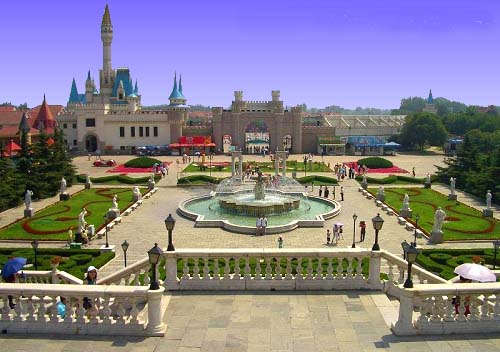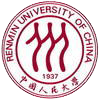Beijing SightseeingVisit Beijing's historical landmarks and immerse in Chinese Culture
The Great Wall is the only man made structure that can be seen from the moon 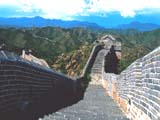
As an emblem of Chinese civilization, a cultural phenomenon of world caliber, and another world endorsed cultural heritage site, the 6350 km Great Wall was in China's feudal years a mammoth defense bulwark that serpentines its way across mountains and valleys in the northern part of the country. The Great Wall came under construction in the 7th century BC, but it was Qinshihuang, the founding emperor of the Qin, who brought it to completion. Repeated extensions were done in later dynasties. The 600-year-old Badaling Fortification in Yanqing County in northwest Beijing is representative of Ming sections of the Great Wall. The Great Wall looks equally breathtaking at such sections as Jinshanling, Mutianyu and Simatai.
China's central square hosting celebrations and demonstrations 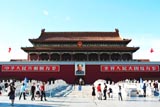
Large enough to hold 1 million people, the 440,000-square-metre Tian'anmen Square in the center of Beijing is the world's largest city square, where sunrises and sunsets are observed solemnly with national flag hoisting and lowering ceremonies. Tian'an men Gate on the northern edge of the square used to be the front gate of the Ming and Qing Imperial Palace. The rostrum atop the gate, where national leaders review mass rallies or gala celebrations on important occasions, is open to tourists. The Monument to the People's Heroes stands in the center of the square. Behind Zhengyang Gate to the south sprawls Mao Zedong Memorial Hall; to the east is the section that houses the Museum of Chinese Revolution and the Museum of Chinese History. The Great Hall of the People stands on the west side. The night scene of Tian'anmen Square is definitely a MUST for any visitor to Beijing.
The 720,000-square-metre Palace Museum, better known as "Forbidden City", was the imperial palace for the Ming and Qing emperors. Built from 1406 to1420, it is the largest royal palatial complex in existence in China; ranging from the majestic to the exquisite, this palace bears witness to a nation in transition. Other tourist attractions on the premises include a huge stone ramp carved with intricate dragon and cloud patterns, Imperial Garden and Nine-Dragon Screen Wall. An immense collection of cultural artifacts and treasures of various dynasties are on display in the Treasure Hall, and the ceramics, painting, bronze ware galleries, are reason enough for UNESCO to adopt the Former Imperial Palace as a world cultural heritage site.
China's largest temple and altar are found in Temple of Heaven, which is now part of a 273 hectare park in Chongwen District. Built in 1420, it was where Ming and Qing monarchs prayed for good harvests. Major structures include the Hall of Prayer for Good Harvest, Imperial Vault of Heaven, Circular Altar, and Abstinence Palace. UNESCO endorsed the Temple of Heaven as a world cultural heritage site in December 1998.
The Summer Palace (Yiheyuan) in the northwestern suburb of Beijing was built in 1750. It is by far the best-preserved imperial garden in China, it was endorsed by the UNESCO in 1998 as a world cultural heritage site. As a paragon of Chinese gardens, this huge garden includes Longevity Hill, whose beauty is set off by a multitude of halls, kiosks and trees, and Kunming Lake, a huge body of silver liquid. Major tourist attractions are Tower of Buddhist Incense, 17-Span Bridge, Long Gallery, Cloud Dispelling Hall, Marble Boat, Beamless Hall, Garden of Harmonious Delights, the theatre in the Garden of Moral Harmony, and Suzhou Street. The entire place is in effect a museum of China's classical architecture. Housed in these buildings are an immense collection of treasures and cultural artifacts.
The Ming Tombs are scattered over an area 40km in circumference in Changping County. Thirteen Ming emperors who ruled China after they moved the capital from Nanjing to Beijing are buried there. The largest is the Changling, built in 1413 for the remains for Zhu Di or Emperor Chengzu. Burial objects are on display from the underground palace of Dingling, the tomb of the last Ming emperor, Zhu Yijun, and his two empresses. Edged on both sides of The Holy Way leading to the Ming Tombs are carved graphical images of 30-odd men, horses and other animals on massive boulders. In terms of size, these stone sculptures are rare in China.
Yuanmingyuan, or Garden of Perfection and Brightness, was built in 1709 as a Qing imperial garden. During its heyday, it was extolled as the "Garden of Gardens", a title well deserved for it was a vast assemblage of gardens and landscaping feats. The unprecedented size and grandeur of Yuanmingyuan, however, are no more for it was ransacked and burned down in 1860 by the Anglo French joint force. Allied forces of the Eight Powers sacked the remaining buildings in 1900. The ruins are preserved today and opened to tourists
An Imperial Garden dating back 800 years Beihai Park, situated to the northwest of Palace Museum, is a typical imperial garden dating back to more than 800 years ago. Buildings are clustered around the famed White Pagoda on Qionghua (Jasper Flower) Island on the lake in the park's bosom. The island provides a vantage point for observing the landscape of Beijing. Major attractions are Circular City, Painted Boat Studio, Studio of the Tranquil Heart, Nine-Dragon Screen Wall and Five-Dragon Pavilions.
Imperial Garden of the Qing, known as Fragrance Hill Lying in the northwest suburb of Beijing, Xiangshan (Fragrance Hill) Park was an imperial garden during the Qing. The peak of the hill, known as Incense Burner Hill, stands 557 metres above sea level. The park, one of the most picturesque spots of Beijing, looks its seasonal best in autumn, when the entire place is covered by dyed crimson maple leaves.
Yonghegong (Palace of Harmony and Peace) in Eastern District had been the mansion of Emperor Yongzheng during his days as the crown prince. After he ascended the throne he had it converted into a lamasery, which has remained as such to this day. Influences of Han, Manchurian, Mongolian and Tibetan architecture are palpable in this complex that consists of three finely crafted archways and five imposing halls laid out tastefully over an area of 66,400 square meters. Among the treasures in these halls is a 26-metre-tall statue of Maitreya (the Smiling Buddha), which is carved out of a single sandalwood trunk.
The largest of its kind in China, the 90-hectare Beijing Zoo is home to 4,000 or so animals in 640 species of which quite a few are from other parts of the world. Among the endangered species are the giant panda, golden-haired monkey, northeast China tiger, antelope, black-necked crane and white-lipped deer. The Beijing Aquarium in the zoo is billed as the world's largest continental oceanic aquarium with more than 10,000 sea creatures in it.
The Beijing Amusement Park in Chongwen District is a large facility with such facilities as a rollercoaster, pirate boats and sightseeing trains.
No botanical garden in north China matches the one in the national capital in terms of size and variety. Sprawling at the foot of the Fragrance Hill in the northwestern suburb of Beijing, the Beijing Botanical Garden is home to 4,500 kinds of plants that are on display in nearly 20 exhibition zones, including a Peony Garden and a Lilac Garden.
This is another large, modern aquarium in Beijing, which is in the possession of 6,000 tropical sea fishes in nearly 100 breeds and Asia's longest underwater tunnel stretching 120 meters.
The Minghuang Waxwork Museum in Changping County is designed to capture life behind the vermilion walls of the Ming imperial palace by combining waxwork art with modern audiovisual, acoustic and lighting techniques.
The city wall, shops, hutongs, teahouses and other scenes associated with life in 15th-century Beijing are recaptured in a collection of miniature structures in this theme park in Changping County, Beijing.
This colossal theme park in Fengtai District is an assemblage of the scaled-down replicas of 106 renowned scenes and sights from 30 countries around the world. |

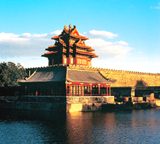 A palace where 24 Chinese Emperors lived and ruled for 500 years
A palace where 24 Chinese Emperors lived and ruled for 500 years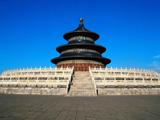 The imperial temple was built in 1420 for worship and sacrifices to Heaven
The imperial temple was built in 1420 for worship and sacrifices to Heaven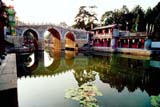 China's second largest and best preserved 800 year old royal garden
China's second largest and best preserved 800 year old royal garden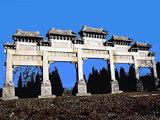 A place where 13 emperors of the Ming Dynasty are buried
A place where 13 emperors of the Ming Dynasty are buried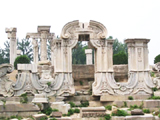 Built in 1709 as a Qing Imperial Garden
Built in 1709 as a Qing Imperial Garden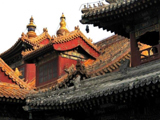 The renowned temple built in 1694 and residence of Qing Emperor
The renowned temple built in 1694 and residence of Qing Emperor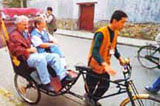 Hutongs are back alleys where old traditions remain very much alive and high-spirited. There are about
4,550 of them in Beijing; ubiquitous in these hutongs are quadrangle dwellings. Close by Prince Gong's
Mansion are some of Beijing's best-preserved hutongs. Touring these hutongs by the traditional pedicab
is rather enjoyable.
Hutongs are back alleys where old traditions remain very much alive and high-spirited. There are about
4,550 of them in Beijing; ubiquitous in these hutongs are quadrangle dwellings. Close by Prince Gong's
Mansion are some of Beijing's best-preserved hutongs. Touring these hutongs by the traditional pedicab
is rather enjoyable.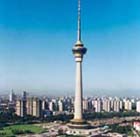
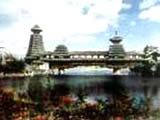 The varied lifestyles of China's 56 ethnic peoples are captured in the Chinese Ethnic Culture Park near
the Olympic Sports Centre in Haidian District. Life size replicas of villages representing ethnic groups
such as the Tibetan, Dong, Miao, Korean and Dai have been built in this park. Everyday, there are song
and dance performances, including production scenes of life in the past relived.
The varied lifestyles of China's 56 ethnic peoples are captured in the Chinese Ethnic Culture Park near
the Olympic Sports Centre in Haidian District. Life size replicas of villages representing ethnic groups
such as the Tibetan, Dong, Miao, Korean and Dai have been built in this park. Everyday, there are song
and dance performances, including production scenes of life in the past relived.